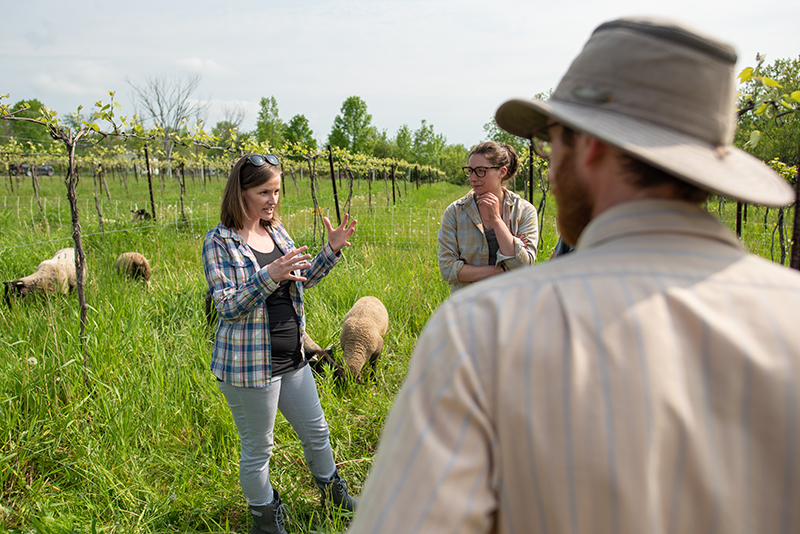In addition to sipping award-winning wines, visitors to Shelburne Vineyard in nearby Shelburne, Vermont, this spring could be found taking selfies with sheep. That’s because the vineyard was home to a flock of five Suffolk sheep happily grazing on the grass beneath the grapevines.
Pairing these two agricultural systems is the focus of a research collaboration between University of Vermont researchers Meredith Niles and Juan Alvez, Shelburne Vineyard winemaker Ethan Joseph ’07, and Greylaine Farm owner Mike Kirk ’09. While unconventional in Vermont, the practice of integrating sheep in vineyard systems has long been recognized for its potential to reduce environmental impacts and improve farmer livelihoods, but the benefits have not yet been fully quantified.
Niles, an assistant professor of food systems at UVM, has been investigating the practice in New Zealand, where an estimated 59 percent of vineyards are integrating sheep. In a country with large-scale wine production, and where sheep outnumber people six to one, New Zealand’s agricultural systems create a symbiotic relationship for farmers seeking to avoid mowing and pesticide use and sheep farmers in need of feed. Niles’ research has shown the practice has resulted in substantial cost savings for farmers and identified potential benefits to the soil and ecosystem. Some wineries have also started incorporating the sheep into their branding message, a potential selling point as more consumers seek sustainably-produced wine.
Trend-Setting
The practice of integrating sheep in vineyard systems is starting to gain momentum in the U.S., with Joseph and Kirk being the first to bring it to Vermont. The two had talked about a potential collaboration for years, but an Instagram photo highlighting Niles’ work was the catalyst they needed. They contacted Niles and within a few weeks had applied for – and later received – a Sustainable Research and Education (SARE) grant to fund the project. Both Niles and Alvez, pasture program technical coordinator with UVM Center for Sustainable Agriculture, serve as technical advisors on the project.
“What we’re doing in Vermont is actually really unique,” said Niles (pictured below, left), who is also a fellow of UVM’s Gund Institute for the Environment. “We designed the study to look at the whole system – the health of the grapes, the animals, the forage and soil, as well as the consumer perceptions, or marketability potential. The existing research on this work has largely looked at these different components in pieces, rather than trying to understand all of these interactions together.”
Sheep offer some of the best natural fertilizers as their manure pellets take time to dissolve into the soil, said Alvez. In addition to measuring soil quality, animal health and documenting how the vines and grapes respond to the sheep, the research team is surveying winery visitors to determine whether the sheep integration influences buying decisions. Inviting visitors to share photos of the sheep on social media also offers free publicity for the producers.
“Many wineries are driven by bringing people in and telling their stories,” said Joseph, who began working at Shelburne Vineyard while studying natural resources at UVM – where he met Kirk. A few years later, he landed a full-time job as the vineyard’s manager and head winemaker. In this role, he has created a new wine label, Iapetus, which aims to promote sustainable wine production and appreciation for the land from which it comes. Kirk, who studied community and international development and went on to found Greylaine Farm, was an ideal partner to help Joseph introduce a new sustainable practice in the vineyard.
“The sheep provide a service that can be beneficial to them, to us, to the soil and the environment,” said Kirk, who works full time at Philo Ridge Farm while his partner Marion Bourgault-Ramsay manages Greylaine. “This project is enabling us to understand what these animals can do for the vineyard and to see how we can expand it.”
Coming Full Circle
What were once necessary means to meet local food needs and protect farmers against weather variability, integrated crop and livestock systems have decreased over time with the rise of farm machinery, synthetic fertilizers and the globalization and specialization of crop and livestock industries. The benefits of integrated crop and livestock systems, in which the outputs of one land use are used as inputs into another, inspired Niles to help co-organize an international group of researchers who are evaluating the reintroduction of these practices in agricultural systems around the world.
“The beauty of this is having the animals to close the cycle. By combining two unconventional enterprises, we are helping to build soil health in the region and providing a model for farmers to succeed,” said Alvez, noting the need for new and creative thinking in the dairy industry and other agricultural sectors facing crisis. “We’re excited about this as a possible model in which farmers bring their animals to graze on land they don’t own.”
The UVM research team is exploring other types of systems that would be well-suited for sheep in Vermont, like Christmas tree farms, hops fields or cider orchards, or even solar panel fields. “Once you start to think bigger about the potential of integrating animals into crop systems more generally, there are lots of other systems you can think about,” said Niles.
Source: UVM News

